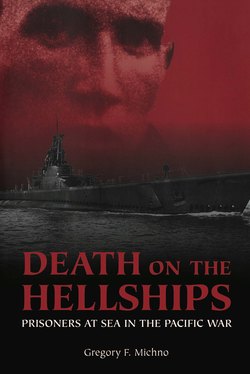Читать книгу Death on the Hellships - Gregory F. Michno - Страница 7
На сайте Литреса книга снята с продажи.
ОглавлениеPREFACE
World War II was arguably the single most important event in the lives of millions of men and women who survived its horrors. It has provided the raw material for thousands of books, many of which were based on the written accounts and memoirs of those who experienced the cataclysm firsthand. Soldiers and sailors, from enlisted men to career officers, have given us numerous combat stories, their narratives running the gamut of wartime emotions, from boredom to terror, from camaraderie to glory.
A significant number of survivors, however, have been unwilling or unable to share their experiences. The majority of the returned prisoners-of-war (POWs) have remained silent. With the exception of a number who made their stories public shortly after the war’s end, POWs have not readily spoken of their ordeal. The onus of having been captured played a part in their silence, as did the unwillingness to relive a bad experience. In some cases post-traumatic stress disorder, a psychological condition that affected many who experienced the brutalities of war, limited their ability to communicate. Many felt guilty about surviving; others were ashamed of what they had been forced to do in order to survive. They blocked out painful recollections. This “psychic numbing” prevented survivors from talking about their experiences for years after the war (American Psychiatric Association, Diagnostic and Statistical Manual, 236–37, 248–50).
It is only within the last few decades that many surviving ex-POWs have finally been able to tell their story. Once the dams broke, a deluge of words poured forth. One ex-prisoner, Robert E. Haney, likened his postwar life to being a tormented, caged dragon. He set up barriers against anything that would remind him of the past. But, he lamented, time did not heal all wounds; it only buried them in very shallow graves (Haney, Caged Dragons, 245).
As Haney’s book illustrates, prisoners of the Japanese suffered unusual brutality. Though Japan had signed the Hague Convention of 1907, which called for humane treatment of POWs, it refused to ratify the Geneva convention of 1929, and its prisoners suffered the brunt of this decision. Recently published POW accounts, including Manny Lawton’s Some Survived, Preston John Hubbard’s Apocalypse Undone, and Van Waterford’s Prisoners of the Japanese (Jefferson, N.C.: McFarland, 1994), have detailed the ordeals of beatings, disease, and starvation, as well as the prisoners’ capture, daily camp life, and eventual rescue. The story of the surrender of Singapore has been told. The fight for Bataan and its attendant Death March has been recounted many times. In contrast, the story of the prisoners who experienced life and death on the Japanese hellships has had less exposure. Some books acknowledge these prisoners, but with no more than a paragraph or, at most, a chapter. (Waterford has a chapter on the hellships, Daws devotes a score of pages to hellships in Prisoners of the Japanese [New York: William Morrow, 1994], and Kerr, in Surrender and Survival, addresses hellships but concentrates on the American experience in the Philippines.) The hellships have not yet had their own story, an incongruous situation given the great number of prisoners who have claimed that their days on the hellships were the worst of their lives. Death on the Hellships is the first book to concentrate on this aspect of the prisoner-of-war experience.
Another comparatively unknown part of the hellship saga is the submarine connection. Thousands of POWs who had survived prison camps on land lost their lives at sea when the Japanese ships they were on were torpedoed by Allied submarines. Chillingly, this “friendly fire” was many times purposely directed by Allied intelligence. Because Japanese codes had been broken, it was possible to know of convoys’ cargoes, destinations, and daily positions, facilitating interception. Japanese ships sailed unaware that Allied intelligence knew of their moves and had vectored submarines to attack them. Of the approximately twenty-one thousand prisoner deaths at sea, about nineteen thousand were caused by “friendly fire” from either Allied submarines or planes. Although Allied death rates under the Japanese were much worse than Allied death rates under the Germans, when one subtracts all of those killed by their own countrymen, the percentages become almost equal.
Can a story of the hellships be written? No, according to Preston Hubbard, former prisoner and retired history professor at Austin Peay State University in Clarksville, Tennessee. Hubbard believes the unrelenting horror of the hellships does not lend itself to a book. Novels or movies need points of contrast, moments of relief, different viewpoints. The hellships, says Hubbard, have no contrasts. Their damned, dark world lies buried beyond the reach of imagination or memory. It was a world unrelieved by humor, light, setting, or routine. Such a story, he claims, would collapse into itself like a black hole, shedding no light and yielding no understanding. Indeed, the hellships may represent a kind of depravity, a supreme form of evil beyond the scope of history (Hubbard, Apocalypse Undone, 164). Although Hubbard’s observation may be valid when it comes to the creation of a painting, movie, or novel, fortunately (or unfortunately, as the case may be), this is not a novel. Truth does not always follow the dictums of art.
